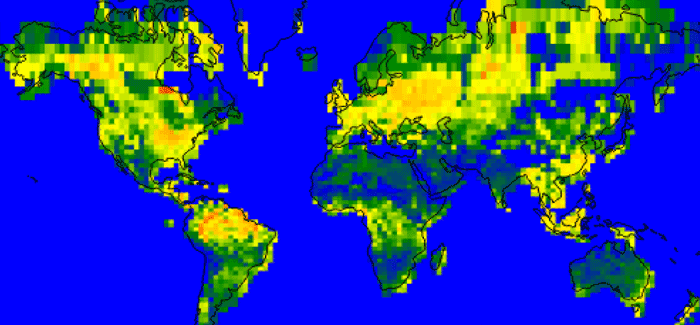
GISS-E2-H Soil Moisture Annual Mean, 2050.
Geophysical Sciences’ David Archer has a way with inconvenient truths.
Undergraduates in David Archer’s Core class, Climate Change: Understanding the Forecast (PHSC 134), don’t have a choice: they have to do the math. The Boltzmann constant pops up early in the first lecture, on heat and light, and by the end of those first 50 minutes in Kent 107, Archer is flinging blackboards up and down to teach these students—resolutely not science majors—how to convert calories into joules and joules per second into watts.
For the more casual learners in his online course Global Warming: The Science of Climate Change, launched in fall 2014 and open to anyone with a fast enough internet connection and a curiosity about climate science, Archer is more lenient. He doesn’t avoid math altogether but says, “I would hate to have you get turned off by not wanting to deal with math.” The online version also skips over quantum mechanics; otherwise the two courses cover much of the same information.
A professor of geophysical sciences, Archer says a course on climate change gives him an opportunity to cover more ground than he can in deep-dive graduate and undergraduate courses like Environmental Chemistry and Global Biogeochemical Cycles. “The question is informed by physics and chemistry and geology, atmospheric sciences, oceanography, energy systems, how social systems work, economics. You get to see a little bit of how all these different disciplines approach a problem, how they think, and how they work by focusing in on this fairly narrow topic.”
The Core class and its online cousin are just two venues for Archer—whose research focuses on how ocean sedimentary processes, such as calcium carbonate dissolution and methane hydrate formation, affect atmospheric carbon dioxide—to share his work with less specialized audiences. Over the years he’s spoken at churches, atheist meetings, libraries, physics departments at other universities, retirement communities, and even Chicago’s Metropolitan Water Reclamation District’s Stickney wastewater treatment plant. “I’ve stopped flying places to give global warming talks,” he says. “They wanted to fly me to Iceland to give a talk at some kind of ceremonial thing. If you want me to fly there, you don’t really get what I’m trying to say.”
And Archer does have something specific to say.
“There’s a lot of concern in the scientific community about greenhouse gases that are very powerful but don’t last very long in the atmosphere,” he notes, giving methane as an example. Cutting methane emissions is cheaper than cutting CO2, but the methane released today has no effect on the temperature in 2040, 2050, or 2060, whereas CO2’s longevity will affect the climate that far into the future.
“I’m what they call a CO2 absolutist in the climate community,” Archer says. “I say keep your eye on the ball, and that is carbon dioxide.”
One of the most frequent questions he gets is about Arctic methane release—“What about those big explosion marks in Siberia?” His response: “The Arctic Ocean is a tiny, tiny source of methane amidst all the rice paddies and swamps and cow farts.” If people start to believe that the natural world is doomed, “they kind of lose all interest in thinking about fighting CO2 emissions.”
Archer does envision a clear way forward. It’s not one big change. “There’s no single thing we can do today that will fix CO2 emissions,” he says, “because we create CO2 emissions in so many different ways.” Rather, like someone trying to lose weight, it’s several smaller changes that add up to a big difference. Those changes are known as wedges. Investing in nuclear power is a wedge. Windmills. “Cars that get 60 miles a gallon instead of 30 could be a wedge,” Archer says, “even if there were a lot more cars in the future.”
When Archer explains why it’s so important to him to share this message in as many ways as he does, he sounds like a colleague teaching a humanities Core course across the quad in Cobb Hall.
“What if the ancient Greeks had figured out fossil fuels? What if they knew what they were doing but did it anyway?” Archer asks. “You know, left the lights on for a century, just sort of frittered it away. And what if we knew today that the world we lived in was degraded because of that? What right would they have to do that? And what would we think of them?”
Socratic dialogue aside, Archer knows he’s not about to be charged with corrupting UChicago’s youth. When he’s spoken to parents of College students at Family Weekend, he says, “They’re all, ‘Yes, teach them this.’”
Last fall Archer took his message to the University’s 521st Convocation, where he addressed “graduating carbon atoms” from across the University. Even with the title “The Great Carbon Conspiracy,” his tone was lighthearted and appropriately inspiring, closing with “a special salute to the sentient carbon atoms—you know who you are. I just want to say watch out for the fossil fuel thing, that’s kind of serious. But I know you’re good for it, so that’s cool.” Here, too, he skipped the math.
Accessing Archer
David Archer offers two versions of his climate change course online. Visitors can learn about different topics in bite-sized portions as recorded for Archer’s massive open online course. Or they can watch an almost raw stream of PHSC 134, which includes students coughing, shuffling papers, and asking some terrific fundamental questions: “Are light and radiation the same thing?”
Archer also offers the public the same interactive climate change models that PHSC 134 students use in labs. Visit climatemodels.uchicago.edu to try them out.
